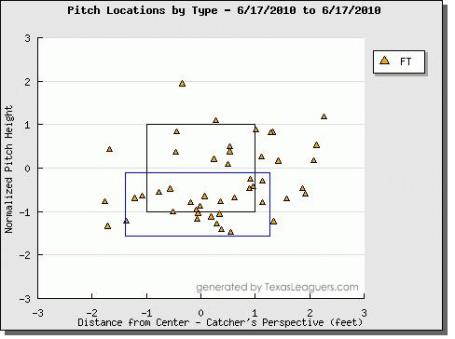It has been said that great expectations often
lead to greater disappointments. Through his first five starts of the season,
Francisco Liriano could not be doing a better job epitomizing that sentiment if
he tried.
Blessed with tremendous raw stuff, enough so
that many wonks figured he could easily compete for a Cy Young award this
season, Liriano has struggled mightily once again with his command, making his
outings as enjoyable to watch as some useless British wedding. In 23.2 innings
of abuse, Liriano has posted a disappointing equilibrium of 18 walks and 18
strike outs. In his first five starts last year, Liriano had tossed 36 innings
with a solid 36-to-13 strikeouts-to-walk ratio and a miniscule 1.50 ERA. What’s
more is that he has already been touched for four home runs, a total that wasn’t
reached until September 7 and required 27 starts to get there.
This year? His peripherals are bad, there’s no
solace in his fielding independent numbers, and he can’t find the strike
zone.
Naturally, Mother Nature was a miserable wench
during his most recent start, sharting snow pellets at the field and making
conditions wretched for pitchers nevertheless, Liriano abided and was cuffed
around by the hot-hitting Rays lineup and was excused from the bitter cold have
three innings and 83 pitches.
After the start, the now 1-4 Liriano tethered
to a 9.13 ERA gave reporters a
self-diagnosis for his woefully start to the season:
"I've got my confidence back. I'm just missing my spots. Just leaving the ball up in the zone. Tonight was a cold night -- not fun to go out and pitch in that weather.”
Unequivocally,
Liriano’s success starts with his fastball. When he is able to throw it over for
a strike on a regular basis, it sets up his slider and change-up. So far this
year, Liriano has struggled mightily to throw his fastball over the plate but
moreover, when he does, it typically is his fastball that is hanging out there
for opponents to slap around.
While Liriano was
never a zen-master of control over his heater last year, he still maintained a
respectable ability to get it over for a strike. That likelihood has plummeted
hard:
|
Liriano’s
fastball command
| |
|
|
Strike%
|
|
2010
|
63%
|
|
2011
|
54%
|
In addition to owning the league’s lowest
strike rate with his fastball, he also has the second-highest well-hit average
(.385) on the pitch as well.
Scouring the video archives, there seems to be
a small yet critical difference in his delivery that could possibly be the
source of his inability to get the ball down. In the first video from 2010,
Liriano dials up a fastball to this particular right-handed hitting Ryan
Spilborghs:

Focus on Liriano in the clip after the
release. During his follow through, he has a significant amount of bend in his
back when finishing, helping keep his offering low in the zone.
Compare that to Wednesday’s delivery:

In this fastball to Tampa’s Sam Fuld, Liriano
remains more upright after his release, not finishing with the same downward
action. The result was a pitch that wound up belt-high instead of knee-high and
crushed to the furthest depths of Target Field. This is a trait that was shared
among several of the other clips from his previous starts this year.
Here is a still-frame:

As you can see, the 2010 version has slightly
more bend helping drive the ball down. Again, it is a seemingly tiny difference
however it could be the distinction between a knee-high fastball and a belt-high
one.
How influential can that minute factor be?
Take a look at the locations of Liriano’s fastballs from those two
outings:

Here we can say that the bulk of his fastballs
feel into the knee-high category. Once again, there are plenty of stray bullets
around the strike zone but a vast majority finished low.

Liriano’s fastball placement on Wednesday was
haphazard at best with a sizeable amount finished up in the zone and over the
middle of the plate.
Why is the difference in Liriano’s delivery? I
don’t know. Certainly there could be a nagging back injury influencing it but
the more likely scenario is that Liriano is still attempting to re-establish the
feel for his mechanics after a long winter away from baseball. When the Twins
refer to his “inconsistent mechanics” this is probably just one of several
glitches they would like to smooth out.
It goes without saying but if Liriano wants to
return to his 2011 form, he’s going to need to locate his fastball in the lower
half of the strike zone on a more consistent basis. My guess? Straight out this
hiccup and we will start seeing him throwing hard at the knees once again.








